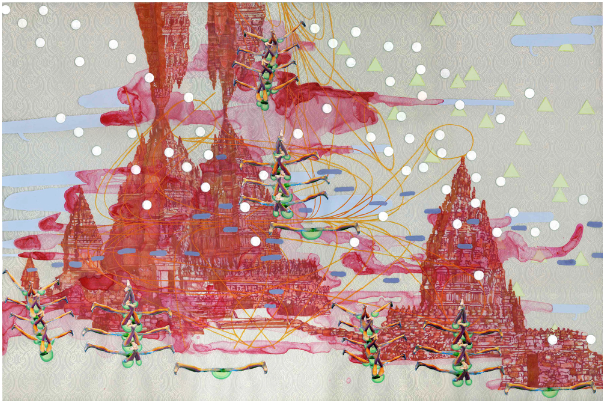
In Ruins
This is artist Melissa Furness, and this area of the exhibition surrounds a conceptual theme that I call In Ruin. So I found that there's a paradox that occurs when one is confronted with ruins. You know, our thinking splits into two paths: one that leads backward in time, and another that travels forward with these two paths that are wandered upon basically simultaneously so the result is this creation of a complex alternative present that I create in the work.
So this area contains some of my earlier pieces, which explore ideas of personal and public ruin. So you'll notice that throughout this, all of this exhibition, there are certain themes that repeat or overlap, but in different visual ways. However, it is really the ideas that are the common thread throughout all of my work. So with these pieces you might find yourself recognizing or at least wanting to recognize the places depicted within them. So, in fact, they're not really any single one place, but a compilation of multiple sites combined to create my own real or surreal space.
So I'm a nerd and I collected snow globes from all the places that I visited because I was interested in them as this distorted and often simplified little worlds that held a memory, you know, of a location. So these pieces, you'll see these dots throughout the spaces which reference these snow globes and at times a child's game where you pull the thread along the line to move it from one location to another.
So additional details that you might notice in these works include line work that go across the pieces. These lines are maps that are historical battle plans for wars that were fought face-to-face, you know, on the ground where one person would have to be directly confronted with another. You also see patterns in these pieces that you might wonder how they were created. So with the drawings, the pattern is screen printed onto the back of the piece. As you can see in the suspended works and within the paintings, the pattern is created through a printmaking process, which is a simplified form of lithography involving a photocopy, water, gum arabic, and oil paint. And so this would provide an initial impression, which I would then go back and paint into to create the final pattern.
So another visual that you will notice are the swimmers that are contained within all of these pieces. They are meant as kind of a metaphor for personal struggle. So being in water, you know, a person becomes ungrounded and buoyant, in order to be able to keep their heads above water and to keep themselves breathing, they have to create, make these repetitive motions physically. And so I was thinking about how we live our lives like this; we repeat ourselves on a daily basis. Getting up and getting ready, going to work and eating, sleeping and other things, but always in a pattern. So if we stop doing these things, our lives would fall apart. And some of the figures have a bit of help. So I was thinking about, you know, those that are born into some sort of privilege sometimes, and they get this extra little help with the depiction of flotation devices and flippers. But also, you know, these can at times be, you know, something of a detriment, depending on the the individual. And so some of these suggest both in subtle ways.
So I'm fascinated with this suggested narrative, and the center of the space is a large altarpiece, which is a collaborative work between myself and artist Rian Korrane who created the cast iron and metal parts of the piece. The work speaks to our shared history of being raised Catholic and with this format of the triptych. This also was a work that led me into those that you'll see in the next space.